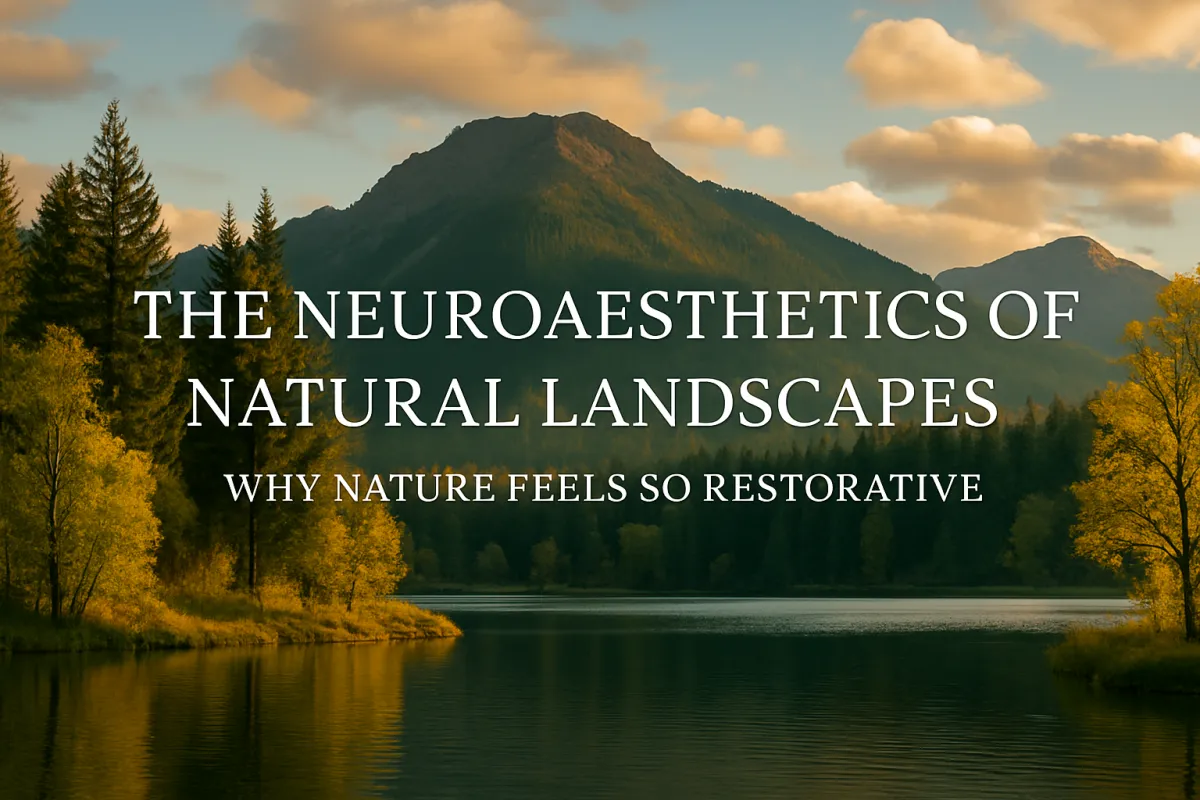
The Neuroaesthetics of Natural Landscapes: Why Nature Feels So Restorative
Have you ever stood at the edge of a mountain lake or walked beneath a canopy of trees and felt an overwhelming sense of peace? You’re not alone. Across time and culture, people have instinctively known that being in nature feels good. But now, neuroscience is catching up—and the emerging field of neuroaesthetics is helping us understand why.
In this post, we’ll explore the brain science behind nature’s healing power, the key environmental features that spark restoration, and how we can design our spaces—urban or rural—to nurture well-being.
What Is Neuroaesthetics?
Neuroaesthetics is a fascinating field that merges neuroscience, psychology, and aesthetics to examine how our brains respond to beauty—in art, music, and, yes, nature. When we view a beautiful natural scene, we aren’t just enjoying a pretty picture—we’re experiencing complex neural activity involving our sensory, emotional, and reward systems.
How Nature Affects the Brain
When we engage with aesthetically pleasing landscapes:
The parahippocampal cortex helps us process spatial layouts and scenes.
The posterior cingulate cortex and frontal cortex become active, encouraging introspection and self-referential thought.
The ventral striatum, part of our brain’s reward system, lights up—suggesting that nature is inherently rewarding at the neural level.
Why Do Natural Landscapes Feel So Restorative?
The Science Behind Restorative Environments
The idea that nature heals isn’t new. Cultures around the world have long embraced nature as medicine—whether through Japan’s forest bathing (Shinrin-yoku) or 19th-century European health retreats.
Modern psychology has formalized this connection through two leading theories:
Attention Restoration Theory (ART): Nature gently engages our attention, helping to replenish our mental focus.
Stress Reduction Theory (SRT): Natural environments lower physiological stress responses, calming our nervous system.
Nature and Mental Health
Numerous studies show that exposure to green spaces can:
Reduce anxiety and depression
Improve mood and emotional regulation
Enhance memory and cognitive function
These mental health benefits align with what neuroimaging reveals—natural stimuli lead to reduced amygdala activity, which is associated with fear and stress.
Key Features That Make Natural Environments So Soothing
Fractal Patterns
Natural scenes are full of fractals—repeating patterns that appear at different scales. Our visual system is especially attuned to fractals with dimensions between 1.3 and 1.5, which are common in trees, rivers, and coastlines. These patterns promote calmness and visual pleasure.
Calming Colors
Green: Associated with growth, life, and renewal
Blue: Linked to tranquility, clarity, and openness
These colors dominate natural environments and are consistently rated as the most calming.
Natural Sounds and Silence
Sounds like birdsongs, rustling leaves, and flowing water activate the parasympathetic nervous system, helping us relax and recover from stress. Just as importantly, the absence of man-made noise gives our brains space to breathe.
Healing Scents
Smells such as pine, lavender, and forest earth have been shown to:
Reduce cortisol levels (the stress hormone)
Improve sleep and cognitive performance
This olfactory input plays a bigger role than most of us realize.
Spatial Layout and Visual Complexity
We tend to prefer savanna-like landscapes—open spaces with clusters of trees and water sources. Evolutionary psychologists suggest this preference may be rooted in our ancestors’ survival needs: safety, visibility, and access to resources.
Evolutionary and Cultural Perspectives on Nature’s Appeal
The Biophilia Hypothesis
Proposed by E.O. Wilson, the biophilia hypothesis suggests that humans have an innate affinity for nature because we evolved in natural environments. Our love of certain landscapes—like those with water or greenery—may be hardwired into our DNA.
Nature Preferences Are Also Personal
While there are universal trends, our individual experiences also matter:
Childhood exposure to nature shapes lifelong preferences.
Cultural values influence how we interact with landscapes.
Genetic differences may even play a role in aesthetic tastes.
Recognizing these differences is key to creating inclusive and effective nature-based spaces.
Real-World Applications of Neuroaesthetics in Nature Design
Urban Planning and Green Space Design
Insights from neuroaesthetics are already helping designers and planners:
Build restorative parks and gardens in urban areas
Enhance therapeutic spaces in hospitals, schools, and workplaces
Create equitable access to nature for all communities
Virtual Nature Experiences
For people with limited access to the outdoors, virtual reality nature experiences—designed using neuroscience-backed principles—offer real benefits. They can reduce stress and even improve focus and mood.
Supporting Conservation
The more we understand the mental health value of nature, the stronger the case for conserving wild spaces and increasing green infrastructure in our cities.
Future Research: Where Neuroaesthetics of Nature Is Headed
Mobile EEG technology may soon let us study brain responses in real time while walking in a forest or watching waves crash.
Personalized environments could be designed to match individual brain profiles for maximum calm and creativity.
Cross-disciplinary research will continue to merge neuroscience, ecology, and design.
Final Thoughts: Why We Need Nature Now More Than Ever
Understanding the neuroaesthetics of natural landscapes gives us language—and science—to explain what we’ve always felt: Nature restores us.
In a world increasingly dominated by screens, stress, and overstimulation, natural environments offer a sanctuary for the brain and spirit. Whether through direct immersion or intentional design, bringing more nature into our lives isn’t just beautiful—it’s essential.
Key Takeaways
Nature activates reward, emotion, and sensory systems in the brain.
Fractals, color, sound, and scent all contribute to restoration.
Both universal and personal preferences shape our responses to nature.
Insights from neuroaesthetics can guide better urban design, mental health strategies, and conservation efforts.
Our connection to nature is not just emotional—it’s neurological.
What part of nature makes you feel most alive? Let me know in the comments—or better yet, take a moment to step outside and experience it. Your brain will thank you.


